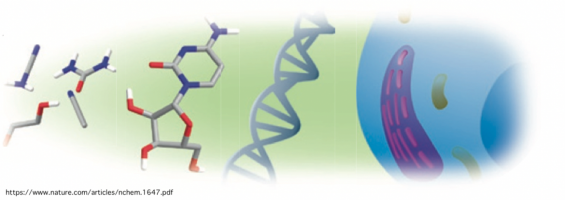Increase of chemical complexity

Emergence of function and biocatalysis from prebiotic chemistry
PI: Prof. Nicolas Winssinger
Funding: DIP
Description:
From a molecular standpoint, the emergence of life tracks with a rise in molecular complexity, from atom to molecules to macromolecules to self-assembly systems with emerging function. Mechanisms for the transformation of atoms and molecules present in an early earth environment to the basic building blocks of life (amino acids, nucleotides, lipids) have been demonstrated (Miller…Sutherland). Mechanism to replicate or amplify genetic information (DNA or RNA) have also been demonstrated (Orgel… Szostak). While oligonucleotides have been shown to be capable of some catalysis, their catalytic efficiency is very low compared to protein-based catalysts, presumably due to the low functional diversity of nucleobases, and natural selection has clearly favored proteins to carry out most of life’s function (assembly, molecular recognition, circuitry and catalysis). Life as we know it today has a very efficient machinery to translate the genetic information into proteins, the ribosome, yielding a direct link between genotype and phenotype. This machine is a spectacular example of self-assembly coming together spontaneously from 55 different components. This represents the successful end-product that enabled a dramatic acceleration in evolution and likely overshadowed all intermediate solutions.
But the question remains, what were the steppingstones to a functional translation machinery? How did complexity emerge from a prebiotic mixture of the building block of life? Nicolas Winssinger's lab has a longstanding interest in methodologies to translate oligonucleotide instructions into controlled chemical reactions and assemblies. Their objective is to demonstrate the emergence of protein-like properties from the assemblies of simple oligonucleotide-peptide conjugates to support the hypothesis that such intermediates were steppingstones towards the sophisticated translational machinery that we know today. More specifically, their work focuses on demonstrating the emergence of catalysis and molecular recognition with allosteric control, a key component of molecular circuitry. The work benefits from the possibility to test these systems in environmental conditions that mimic Hadean-Archean conditions through CVU collaboration (see next project). Of particular interest is the role of minerals and rocks in providing a microenvironment conductive of chemistry.
Selected references:
• Reactions Templated by Nucleic Acids: More ways to translate Oligonucleotide-based Instructions into Emerging Function, K. Gorska, N. Winssinger Angew. Chem. Int. Ed. 2013, 52, 682-6843
• Allosterically Regulated Phosphatase Activity from Peptide-PNA Conjugates Folded Through Hybridization, T. Machida, S. Dutt, N. Winssinger, Angew. Chem. Int. Ed. 2016, 55, 8595-8
• Coupling of DNA circuit and templated reaction for quadratic amplification and release of functional molecules, K.T. Kim, S. Angerani, D. Chang, N. Winssinger, J. Am. Chem. Soc. 2019, 141, 16288-16295
• Suprastapled Peptides: Hybridization-Enhanced Peptide Ligation and Enforced α‑Helical Conformation for Affinity Selection of Combinatorial Libraries, P.M. Sabale, M. Imolek, P. Raia, S. Barluenga, N. Winssinger, J. Am. Chem. Soc. 2021, 143, 18932-18940.
• A mating mechanism to generate diversity for the Darwinian selection of DNA-encoded synthetic molecules, Vummidi, B.; Farrera-Soler, L.; Daguer, J.-P.; Dockerill, M.; Barluenga, S.; Winssinger, N. Nat. Chem. 2022, 141-152.
• Biosupramolecular networks: taking inspiration from nature to create powerful synthetic platforms, E. Watson, N. Winssinger, Curr. Opinin. Chem. Biol. 2022, e23485
A global hydrothermal reactor triggered prebiotic synthesis on Earth
PI: Prof. Nicolas Winssinger, Prof. Luca Caricchi
Collaborators: Chiara Boschi and Andrea Dini (Institute of Geosciences and Earth Resources, CNR, Italy)
Funding: Not funded yet, but hopefully soon
Description:
Biosignatures in the rock record limit the time available for life to start on Earth to 600-800 million years (4.5-3.7 Ga; Hadean-Archean). Hydrothermal environments have been postulated as privileged environments for the emergence of life but, today, they are present on extremely small portions of the Earth. The specific tectonic conditions of the Hadean made our planet a global hydrothermal reactor, thus maximizing the probability of occurrence of favorable environments for the emergence of the building blocks of life. Phosphorus and boron, considered essential for the synthesis of prebiotic molecules, were extremely scarce on Hadean Earth. The establishment of a global hydrothermal reactor resulted in the production of enormous quantities of brucite, a mineral capable of absorbing and concentrating both elements. However, the impact of brucite on prebiotic chemistry, in particular, the catalytic properties of porous minerals with a surface functionalized with boron and phosphate have not been investigated. While organophosphates are central to life as we know it (DNA, RNA, phospholipids, energy currency), the scarcity of phosphate in prebiotic oceans, lakes and pools is prohibitive for the emergence of life. Capitalizing on the existing expertise at the University of Geneva and ongoing collaborations with the CNR in Italy, in the framework of the Life in the Universe initiative we have designed an experimental workflow to test the catalytic role of brucite on the emergence of prebiotic molecules. Specifically, porous brucite with high surface area of boron and phosphate, doped with different metals such as iron (FeII or III), will be used to test its impact on the formation of RNA and lipid precursors under prebiotic conditions.
